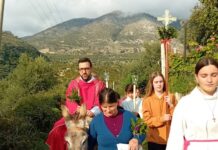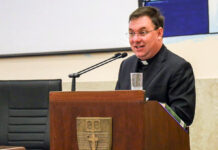One hundred thirty years ago, members of the Federation of Catholic Workers’ Circles, on the initiative of Father Federico Grote CSSR, went to the Basilica of the patron saint of Argentina.
The first pilgrimage of workers to the feet of Our Lady, the Virgin of Luján, patron saint of Argentina, took place on 29 October 1893. Thanks to the Redemptorist priest Federico Grote, founder of the Federation of Catholic Workers’ Circles, some 400 workers went on a pilgrimage to the Basilica of Luján.
It was then that, at the end of the 19th century, Leo XIII became the first Pope to write an encyclical letter, “Rerum Novarum”, in defence of the workers. In those years, workers fought for their rights in the face of capital exploitation, and the Church supported them. However, it did not accept violence and anarchy as a method for the poor working people to respond to the total absence of labour rights. It was in this context that Grote, a German priest of the Congregation of the Most Holy Redeemer, arrived in Argentina and embodied the defence of the exploited along the lines of “Rerum Novarum”.
In his memoirs, compiled in the book “La vida del Padre Grote, el apóstol de los trabajadores” by P. Alfredo Sánchez Gamarra, it is described that 130 years ago, he was organising the pilgrimage to Luján: “I wanted to place the work under the protection of the Virgin so that She herself would take care of it. 29 October was the decisive day in the life of the circles. Four hundred men accompanied me to Luján. Before the Virgin, we swore to remain firm in our purpose of redemption of the humble, and we vowed to come every year en masse before her image so that she would keep our persevering energy intact,” Sánchez Gamarra recorded his memory.
“The pilgrims were accompanied by a music band from the school of the Círculo Central and numerous Argentinean flags. The vicar general of Buenos Aires, Monsignor Agustín Boneo, wanted to lead the pilgrims to Luján”, says the book “Father Federico Grote a missionary among the workers” by Roberto Etcheverry. Three years later, 4,000 workers went on a pilgrimage accompanied by the then Archbishop Castellano. The pilgrimage consisted of taking the train from Once station to Luján. Once in the Basilica, they would attend mass and a speech at the altar by a member of the circles and then return by train. From Miserere on foot, they went to Plaza de Mayo to the Archbishop’s house or the Government House. In 1901, some 5,000 workers carried, in addition to their circle banners, Argentine flags and musicians, a petition for their rights. “We asked for the law of Sunday rest and the protection of the work of women and minors. We were received by President Roca and the Minister of the Interior, Mr. Gonzalez”, Grote recounted in his memoirs.
The creation of the workers’ circles, which Fr Grote never wanted to call Catholic because he felt that it should unite people beyond the Catholic faith but with a deep spirituality, did not go down well with everyone in the Catholic world. A part of the Church hierarchy and the laity were frightened by his defence of the dispossessed. In addition, Fr Grote was pushing for an institution led by the laity and not the clergy. That is why the workers’ circles were initially accused of being Marxist and atheist. In his memoirs, Fr Grote himself acknowledges this and even confesses that his tactic for uniting the workers “was not the observance of the norm of the practising or convinced Catholic”. For him it was enough with “action, example and charity that were achieving very numerous conversions”.
Although Fr Grote was the first in Argentina “to promote the social doctrine of the Church”, as the then Cardinal and Archbishop of Buenos Aires, Antonio Quarracino, acknowledged, he is one of the Church’s forgotten men. This was admitted by Card. Jorge Mario Bergoglio, now Pope Francis, at one of the events marking the anniversary of the Federation of Catholic Workers’ Circles from the stage of his theatre located at its headquarters at 1063 Junín Street, between Santa Fé Avenue and Paraguay, in the Recoleta neighbourhood of Buenos Aires.
In the same theatre where Bergoglio was present decades before, there was another legendary figure in Argentine history. Colonel Juan Domingo Perón, wearing a military sash, at the time Minister of War and Secretary of Labour and Social Security, spoke to the young people at the launch of vocational training. The Federation of Circles tells us today that Perón was carried out that day by a crowd of young people, and they also give photographic proof of that day, where Perón speaks with a banner of the circles behind him with his motto: “Dios, Patria, hogar” (God, homeland, home).
Today, the Federación de Círculos Católicos de Obreros is a big family ranging from 1200 employees in its social work (known by its initials OSAMOC), a real pre-payment of the poor that was encouraged to affiliate the so-called cartoneros organised in the Movimiento de Trabajadores Excluidos (MTE) as well as the members of the Familia Grande de los Hogares de Cristo (the device of the slum priests for the excluded), which includes the San José sanatorium in the city of Buenos Aires at 1667 Billinghurst Street, founded in 1938, a clinic with care and hospitalisation in the town of Jauregui (near Luján), outpatient clinics in San Isidro and a small first-aid clinic in Punta Batel, Goya, province of Corrientes.
One hundred thirty years after the first pilgrimage of workers to the Virgin of Luján, Enrique Ciro Bianchi, professor of pastoral theology at the Pontifical Catholic University of Argentina (UCA), rightly reflects that “pilgrimages have been, throughout the history of Christianity, an icon of the Church as people and family of God, a kind of sacramental of the pilgrim Church and that in Latin America our people love pilgrimages, an expression that is confirmed by the enormous number of shrines scattered throughout the continent. Behind this incessant pilgrimage to the Virgin, there is a mystery that speaks to us of our people, of their faith and of their way of being Church. For this reason, and as a genuine expression of popular piety, theological reflection on evangelisation is called to pay attention to it”.
The Pope spent long nights in the Basilica contemplating the pilgrim people passing under the gaze of Our Lady, and a certainty grew in his heart: Our Lady touches the lives of the people. In this encounter of looking and being looked at, there is an action of divine grace. This conviction is not born of an abstract reflection but of the direct contact of the pastor with the suffering of the people.
(diarioelargentino.com.ar)







